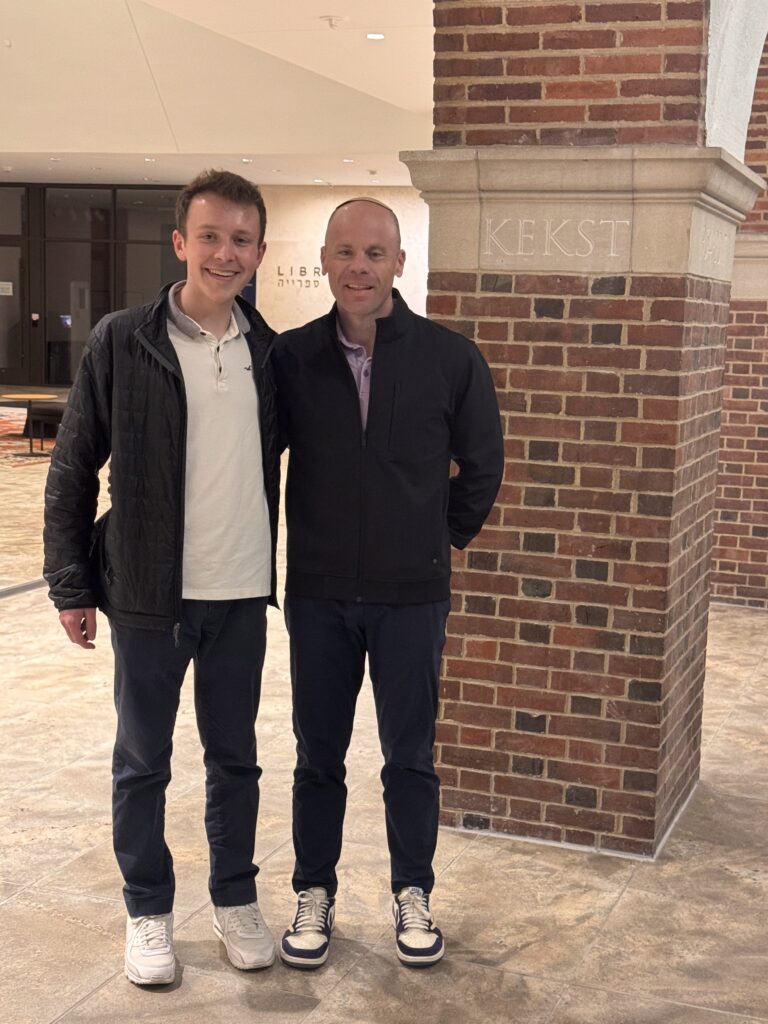
I was in New York tonight and tomorrow for the AJC Global Summit and decided, albeit reluctantly, to take a field trip.
It’s been nearly fourteen years since I walked across the stage at the Jewish Theological Seminary of America, diploma in hand—relieved, proud, and exhausted. In May 2011, I closed the chapter on six of the most formative—and at times tumultuous—years of my life. Tonight for the first time since I can remember, I returned.
The building itself has changed almost beyond recognition. The halls where I once memorized the commentaries of Rashi and Ramban have been streamlined and modernized. Glass and steel have replaced much of the old wood and stone. The stairwell that always reminded me of Hogwarts remains, but the creaky intimacy of the past has given way to a sleeker, curated future. Yet as I wandered through the corridors, it became clear: JTS is not contained in its architecture. The spirit of the place—the invisible architecture of memory, of yearning, of ambition and doubt—remains untouched.
I first entered JTS in the fall of 2004, certain I was an impostor and unsure whether I belonged at all. I was twenty-four, fueled by an anxious love of Judaism but quietly convinced that eventually someone would catch on to the fraud I believed myself to be. Everyone else seemed sharper, more knowledgeable, more certain of their place in this great chain of tradition. I spent years waiting for the tap on the shoulder that would expose me. It never came. Professors Diamond, Lehman, Gillman, Roth, Harris, Cooper, Savenor—and so many others—saw something in me. Blessedly, they let me stay.
As I walked the halls again, the ghosts came to greet me. I could feel Solomon Schechter’s presence—the unrelenting drive to weave tradition and modernity into a single tapestry. I sensed the rigor and brilliance of Chancellor Finkelstein lingering in the walls, the unshakable belief that Judaism could not only survive but flourish in America. Above all, I could almost hear the slow, deliberate footsteps of Abraham Joshua Heschel, his voice thick with moral urgency, reminding us that to pray is to dream with God. And I could picture Dr. Saul Lieberman ascending the stairwell, a sefer in his hand, immersed in worlds of learning.
I sat down in one of the lecture halls, closed my eyes, and listened. There, in the stillness, Rabbi Neil Gillman, z”l, reappeared, challenging us to wrestle honestly with the theology we had inherited and to forge something real from it. I could hear Dr. Walter Herzberg, lovingly recount his encounters with Nechama Leibowitz z”l,holding up her intellectual rigor and religious devotion as models for us to aspire toward. I made my way to Stein Chapel, sat in a chair, feet firmly planted on the ground—and for a fleeting moment, I could hear Dr. Frankus, z”l, leading Selichot, his voice weaving ancient longing with contemporary hope.
Memory has a way of flooding back when you least expect it. I hadn’t intended to have an emotional reckoning. I thought I was visiting a building. Instead, I found myself being visited.
And then, something remarkable happened.
I wandered into the Women’s League Seminary Synagogue. Two students—young, unknown to me, likely still children when I graduated—were sitting in the sanctuary, singing. Their voices rose in harmony, pure and unselfconscious, like sparks ascending to the heavens. We asked if we could sit and listen. They were honored. I wonder if I was meant to be there at that exact moment, if that beautiful music was placed there to lift my soul.
In that moment, the cynicism and fatigue I sometimes carry toward JTS—the frustrations with its bureaucracy, its ideological battles, its occasional smallness—faded away. For all its imperfections, JTS is still doing something holy. It is still tending to the sacred spark. It is still producing some of our best and brightest.
And for the first time in a long time, I felt hope. Hope for the Jewish future. Hope for the next generation of leaders who will dare to dream, to challenge, to build.
It struck me then how complicated love is—how it is shaped as much by disappointment as by devotion. I did not always enjoy my time at JTS. There were days I felt crushed by the weight of expectations, days I bristled at the narrowness of certain conversations, days I questioned whether I was being prepared for real Jewish leadership or merely being trained to pass exams.
Yet no matter the answer, they filled my cup.
As Heschel put it, JTS made me a “text person.” They gave me texts, ideas, questions, frameworks. They gave me friends and mentors, challenges and epiphanies. They taught me how to learn, how to doubt, how to pray. They taught me that it is possible to love a tradition fiercely and still demand more from it—and from myself.
For that, I will always be grateful.
I walked out of the building slowly, reluctant to let go of the moment. I turned once more to look at the façade—familiar and unfamiliar at once—and offered a silent prayer: that the students studying there now will be brave enough to wrestle honestly, to cherish fiercely, and to build wisely.
Perhaps I will return again in another fifteen years. God willing, I will have changed even more by then. God willing, JTS will have changed too.
That is, after all, what institutions—and souls—are meant to do: to honor their ghosts, even as they make room for new dreams.
Leave a Reply